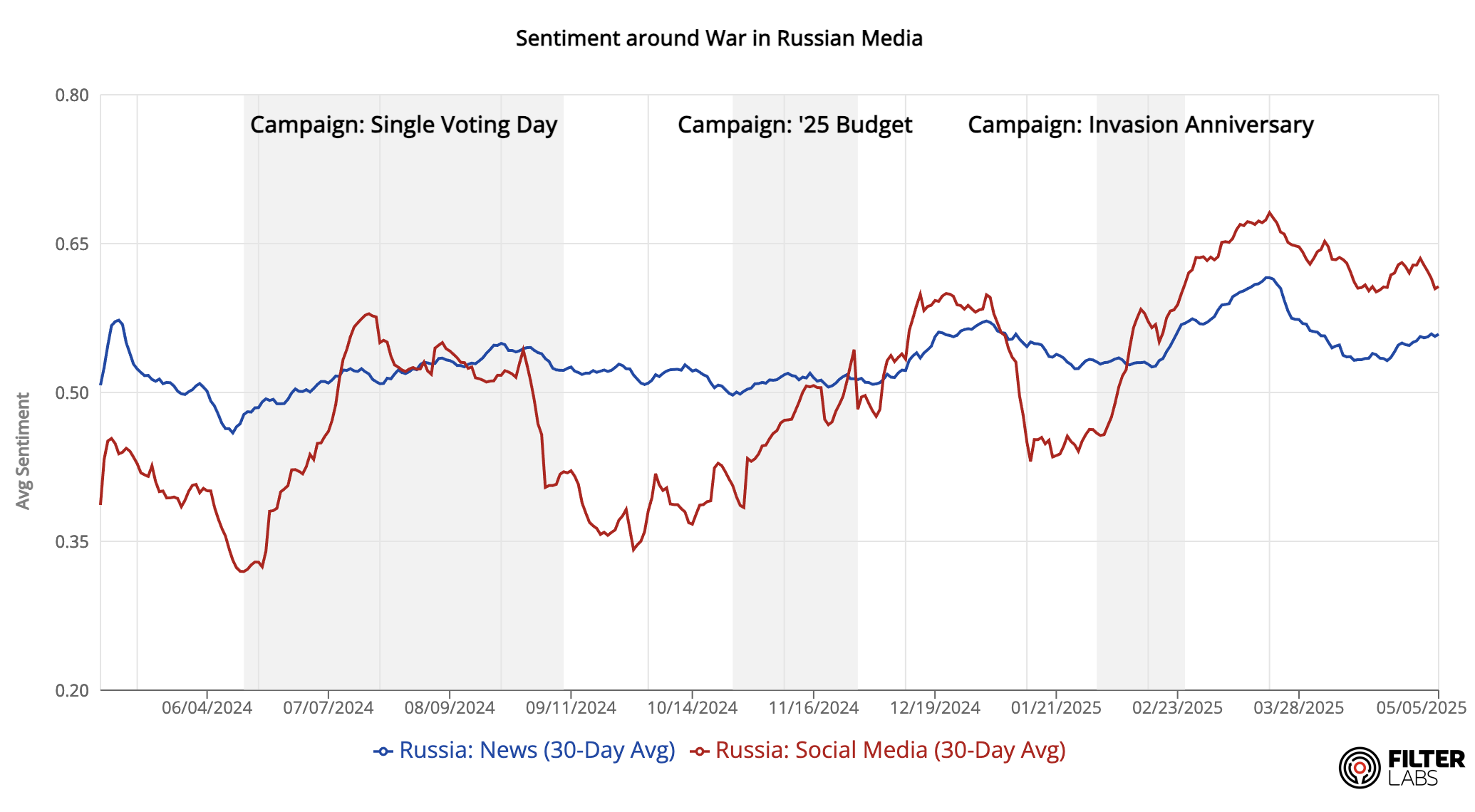Propaganda and Grief: A Year on Russian Internet
As is his custom, Russian president Vladimir Putin celebrated Victory Day (an annual celebration of victory over the Nazis) with an extravagant parade. Smiling soldiers. Cheering crowds. Propaganda-laden speeches. The usual.
The spectacle got us wondering: what were the main lines of Kremlin war propaganda online since the last V-Day?
With Talisman, our data analytics platform, FilterLabs can identify and track information campaigns over time. Looking back, we found a few time-bound campaigns, including the ones highlighted on the chart above. There were also several ongoing pro-war campaigns, conducted largely on social media, that jumped out as we examined the Russian information environment over the past year:
- Popular support for the war. We found repeated pro-war posts across OK in groups unrelated to politics or government-run pages (a classic indicator of inauthentic online activity): “The public support for the Russian army and its actions during the special military operation is at an unprecedented level! During the entire SVO, at least three quarters of our fellow citizens support the Russian Armed Forces on the front lines.”
- The government supports the troops, too. There were numerous posts about government financial support for veterans and/or their families. The posts also included military contract advertisements, appealing to the material benefits of signing up and the patriotic “manly duty” of service.
- Local benefits. Before the September elections, there was a special effort to tie pro-war politicians to local development projects. For example: “Questions about the construction of a multidisciplinary center for SVO participants were discussed with the head of the Volgograd region, Andrey Bocharov, who held a meeting on the topic of implementing a large-scale project in Volgograd.”
- The humanity of the Russian Army vs. the cruelty of Ukraine. Around a prisoner exchange last May and June, Russian media was full of state-sponsored stories about a Russian soldier who had peacefully convinced Ukrainian conscripts to surrender. In the words of one article, “these were ordinary Ukrainians who were mobilized. They said that they did not want to fight, but were afraid to surrender. Soroka dispelled their fears. He added that ‘nobody laid a finger on the Ukrainian guys.’”
They likely felt these campaigns were necessary because, as FilterLabs also found, there were a lot of negative feelings around the war from ordinary Russians. On Russian social media, FilterLabs found several recurring themes:
- Lost Lives. A common theme was regional losses. Some bereavement posts were written by widows, like this one on VK: “[The government] heads send people to their deaths, especially the young, while they themselves sit and hide their asses and keep their sons abroad.”
- Ukrainian attacks. Many posts expressed outrage over civilian deaths.
- Delayed or denied benefits. In contradiction to Kremlin propaganda, many said that they were struggling to access welfare benefits. One poster on OK complained that immigrants were getting housing benefits ahead of veterans: “But in the Duma they shout from [the rooftops]. [We] provide assistance to the participants of the SVO and their families. Well, thank you for such assistance.🦁”
Moscow’s V-Day will always be a propaganda spectacle, a romanticized reminder of its bygone military might. What’s more notable is that, with the war in Ukraine dragging into its fourth year, the Kremlin feels the need to keep its propaganda machine running year 'round.
Explore the Data in Talisman
Have questions of your own? Want more hyper-local insights into hard-to-reach places (like Russia) around the world? Check out the live data on our analytics platform, Talisman! All subscribers can check out the live version of the chart above; those with full-access subscriptions can also investigate the individual artifacts underlying it, and so much more.
If you don’t have a Talisman account yet, sign up now—a basic subscription is free!
%20-%20Tradmark.png)
